APPENDIX B: 20TH CENTURY POPULAR MUSIC
The Blues Progression
This section is best read in conjunction with the links to the main book section of this website. Whilst there are many good books and websites that describe chord progressions in popular music, what is unique about this website is that it describes the underlying principles which govern chord progressions in tonal music. By understanding these, the reader will be able to understand the wide range of tonal (and some modal) chord progressions possible and understand how these relate to musical phrases.
This section should be read after the section on the three chord trick.
Outline Description of the Blues Progression
Before discussing chord progressions in the blues, I'll give a brief overview of the blues, please refer to the bibliography and web links for further details.
One of the most important influences on popular music in the 20th Century is that of The Blues. The Blues emerged around the start of the 20th century (possibly earlier). It fused African scales and rhythms and ways of singing with western harmony and instruments. It influenced: jazz; popular songs of the 1930's; Rhythm and Blues; Rock and Roll and other 'rock' and 'pop' genres.
The blues is a folk style thought to originate from African slaves in the Mississippi Delta of North America. It is characterised by a highly expressive vocal style which involves a high degree of pitch bending of notes. African slaves would have been familiar with western music via the popular and church music of the time. The result is a fusion of African scales and ways of singing with western harmonic structures.
The Melodic Blues Scale
There is no fixed melodic scale for the blues, different blues melodies use different notes. However, the simplest way to explain the blues is that it is similar to the the western major scale with the 3rd and the 7th of the scale flattened. These are referred to as 'blues notes'. Often the flattened 3rd completely replaces the major 3rd in a melody but sometimes they are both used. Some melodies also contain the flattened 5th degree of the scale but this is often used as a passing note between the 4th and 5th degree of the scale. These 'blues notes' as well as other notes of the scale are subject to pitch bends and slides. The simplest version of the blues scale (based on C) could be described as follows:
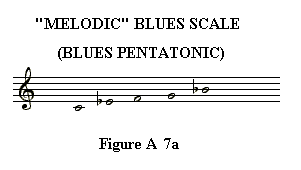
This is normally referred to as the 'Blues Pentatonic Scale' because it contains the 5 notes and these are the most commonly used in blues melodies. It includes tonic (C), subdominant (F) and dominant (G) notes of the scale as well as the 'blues' 3rd (Eb) and the 'blues' 7th (Bb). Many blues melodies use just these notes. This scale is also used as a basis for improvisation.
It is very important to note that, whilst this scale contains the minor 3rd, these are performed against major chords in the accompaniment. (Often with added 7ths - see later.) So the minor 3rd (Eb here) sounds against the major 3rd (E) in the accompaniment. This clash between the major and minor thirds is central to the sound of the blues. Without this the music is not blues but modal (For more on the modes see the next section.) For instance, if the scale above is accompanied by a C minor chord rather than a C major chord, then the effect is of the Aeolian, Dorian or Phrygian mode (depending on which other notes are present) and not blues. It is also worth noting that the term 'blue note' is a term introduced by western musicologists and not a term originally used by blues musicians.
Examples of notes that blues melodies frequently have in addition to these notes are: the second degree of the scale and the major 6th degree of the scale. If both these are added, and no other, then the scale is the Dorian mode (but of course set against major chords not the normal Dorian harmonies). Sometimes the flattened 5th is added as an additional 'blue' note. Sometimes both the major and minor third are present in the melody, especially in piano blues or rock and roll melodies. Pitch bending can be used in conjunction with any note of the scale. Sometimes the flattened 6th degree of the scale is used as an additional blues 3rd against the major subdominant chord.
This highlights an important difference between the blues and modal music. In modal music (and to a large extent in tonal music) the accompanying chords follow the notes of the mode (or key), Minor chords are used if the mode or key is minor. In contrast, in the blues, major chords are used against the minor 3rds in the melody. (Except in 'minor blues' which is a later development). Thus there is a degree of independence between the (variable) melodic blues scale and the more or less fixed accompanying major chord harmony.
Blues Harmony
Just as we defined the three main chords in tonal music in the last section, by repeating the three chord trick, we can determine the three main chords used in the blues as follows:
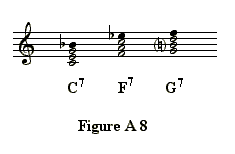
These are the same three chords: the tonic, subdominant and dominant chords of the key positioned on the first, fourth, and fifth degrees of the musical scale which is why they are often referred to (using roman numerals) as chords: I7, IV7 and V7. 'I' refers to the chord on the first degree of the scale; 'IV' the chord on the 4th degree of the scale and 'V' the chord on the 5th degree of the scale. (Here 'degree' refers to steps as in the major scale.) In the blues on C, these are: C7, F7 and G7. However, unlike in the previous example, these are all 7th chords made up of a major 3rd, a perfect 5th and a minor 7th. They are all constructed in the same way as the dominant 7th chord in conventional tonal music but in the blues there are three of these chords. These are the three chords most used in the blues (mostly with, but sometimes without the added 7ths). In classical harmony, F7 and C7 would be chromatic chords (because they contain notes out of the major scale) and would be treated as discords (because they contain a 7th which is dissonant). They are usually described as secondary dominants (because of their similarity to dominant 7th chords) and have to be treated in a special way in classical music.
If we rearrange the notes of the three chords (by moving some down an octave) then we get the following scale from these harmonies.
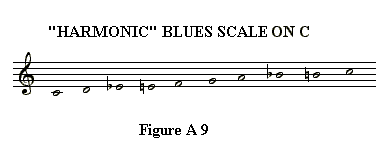
C is from the C chord, D from the G chord (an octave down), E flat from the F7 chord (an octave down), E from the C chord, F from the F7 chord and so on.
This scale represents the main notes used in the blues to create: harmonies and blues bass lines and also represents the fuller set of notes commonly used in blues melodies, especially in piano blues and boogie woogie and in Rock and Roll and rock and pop music influenced by the blues. As indicated above, sometimes a flat 5th is used as an additional 'blue note', or as a passing note.
This scale is similar to the major scale of western tonality with an added minor 3rd and and added minor 7th. It is the juxtaposition of the major and minor third of the scale that is the key factor that makes a blues sound like blues. This juxtaposition can occur in the melody (both major and minor thirds present) or sometimes only the minor third occurs in the melody whilst the major third occurs in the underlying harmony.
In classical tonality, the three 7th chords shown above would be treated as discords that have to be prepared and resolved in a special way. However, in the blues these are treated as consonant chords i.e. as chords that do not require preparation or resolution. This has a very important consequence for blues harmony. That is: it is possible to have the following chord progression as static harmony (see below for more details):
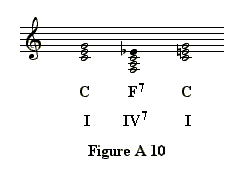
The C chords may have added 7ths. This progression is not possible according to the normal voice leading rules of classical harmony because the 7th of the chord IV would have to resolve onto a chord containing a note below the 7th. In the example above, the Eb would have to resolve to D (or Db) which does not exist in the C or C7 chords. See Voice Leading Appendix entry The Blues 7th and the glossary entry: Voice leading.
This is the quintessential blues harmony and in all the variations of the blues progression this is the most constant part of the progression. It produces the juxtaposition of the major 3rd of the scale (E in the example above) in chord I with the minor 3rd of the scale (Eb) in chord IV7. This juxtaposition can occur within the melody or between the melody and the harmony and is the defining component of the blues sound especially as handed down to genres influenced by the blues.
Blues songs are normally sung in a standard AAB form. The first line forms the 'statement' and takes up 4 bars of melody usually sung to chord I7. The first line of melody is usually repeated but with a change of underlying harmony (chord IV7 followed by chord I7). This is then followed by a 'response' of a further 4 bars over a cadential chord pattern (V7 - IV7 - I7). This results in a standard 'twelve bar blues' pattern as follows:
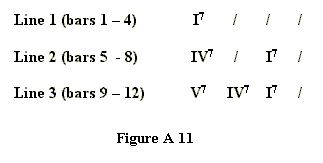
The chord I does not always take a 7th but IV and V nearly always do. Often the 7th is present in the melody. Sometimes one or more of the chords takes on an added 6th instead of an added 7th. Sometimes, especially in early accompanied vocal blues the same chords are used but over a different number of bars. i.e. 13 bars, 14 or 15 bars. It is not the number of bars that is important but the sequence of chords. The number of bars became standardised, later, when a number of performers playing together in a group became the norm.
Sometimes there is an additional chord IV (7) in bar two and/or an additional chord V(7) in bar 12. This latter is normally referred to as a 'turnaround' chord as it acts as a dominant 'lead in' to the next 12 bars. This form (with or without these additions) is the most common form of the blues progression. The vast majority of blues songs follow this pattern. ( I would say over 95%)
Examples of this structure are numerous. They include most of the early blues songs, for instance, Robert Johnson's Me and the Devil Blues is an examples from the classic 1930's Mississippi Delta blues era. Many later blues influenced songs also follow this structure, for instance Little Richard's hit Good Golly Miss Molly (Blackwell and Marescalco) and The Beatles Can't Buy Me Love.
Variations on the basic Blues Progression
There are a small number of blues songs that retain the chord V into bar 10 (i.e. missing out the chord IV) An example of this structure is Robert Johnson's song Cross Road Blues. It is an example in 15 bars. The chorus of the Rolling Stones hit Satisfaction does this and a further well known example of this simplified pattern is the Rock and Roll Classic: Rock Around the Clock (Freedman & De Knight) made famous by Bill Halley and his Comets.
A small number of early blues even go as far as using only one or two chords which form a kind of drone backing. Robert Johnson in Preachin' Blues (Up Jumped the Devil) accompanies with just a single E 7 chord throughout (there are a few passing notes). Muddy Waters in Rolling Stone accompanies with a I - IV7 - I pattern throughout the verse. Neither includes the dominant chord.
A small number of blues songs add dynamic harmony (see previous section) in the third line. For example IV - IV - V - V is deployed by Fats Domino in Ain't That a Shame and I hear You Knocking. However, these examples are not common in blues that is not jazz influenced. The most common form is the one shown above (Fig A 11.) with or without an additional IV in bar 2 and/or an additional V in bar 12.
For more on dynamic harmony see the previous section and Chapter 2.
The Blues Progression and Syntactic Structures
If we compare the structure of the standard 12 bar blues as shown above (see Figure A 11) with the syntactic structure as demonstrated by the Bob Dylan song in the last section, (See Figure A 6) we can see that there are some differences. This structure starts the same way, i.e. the phrase starts with static harmony as follows (again, showing the chord relationships without the bars):

- [ ] indicates an auxiliary chord, i.e. a chord which returns to the previous chord and consequently is used for creating static harmony.
- Chord IV (the subdominant)
is the most popular auxiliary chord in popular music for forming static
harmony but other chords can be used.
Static harmony is harmony which oscillates around one chord, normally the tonic but sometimes the dominant, i.e. there is a movement from the tonic chord to another chord followed by a return to the tonic. Because the harmony here oscillates around the tonic it prolongs the tonic chord. Static harmony is a structural component of the musical phrase and normally occurs at the start of the musical phrase.
For more on static harmony see book Chapter 2.
In contrast, as explained in the last section, dynamic harmony is a progression of chords. It is important to understand the distinction between static and dynamic harmony in order to understand how chord progressions work in tonal music (and to some extent in modal music - see later).
For more on dynamic harmony see Chapter 2.
It will be noticed that, unlike the Bob Dylan song in the last section, this phrase does not contain dynamic harmony and therefore represents a simplified version of the basic syntactic structure. The blues is harmonically simple in contrast with the rich chromatic, modulating harmony that was popular in the 1900 century and in much tonal popular music well into the 20th century. The simplified syntactic structure here reflects that greater simplicity and allows greater flexibility in the melodic structures (bending of notes and combined major and minor 3rds). Note: the Fats Domino variation mentioned above does add dynamic harmony.
The static harmony, here, is immediately followed by the cadence. Also, it will be noticed that the cadence is not the standard
![]()
perfect cadence but there is an additional chord IV7 in-between the cadential chord V7 and the cadential chord I.
The phrase can thus be represented as follows:
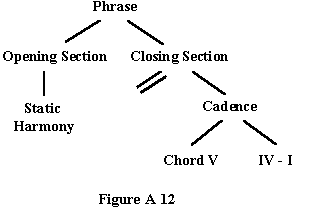
The double dash mark indicates that here is no dynamic harmony and the
final chord I is replaced by IV - I. This variation of the basic structure
(without dynamic harmony) is used for short pieces of music where the
same pattern is repeated. This is often used for songs with short repeating
structures, in both popular and classical music. In the case of the blues
structure the chord I is normally replaced by the IV - I combination.
The chord IV7 acts as an appoggiatura chord to the cadential I7 chord. The appoggiatura chord is one type of non-structural (or non-functional) chord which is used here to elaborate the final chord I but the underlying cadence is nevertheless the V to I cadence. Note: this pattern only occurs at the cadence and, as indicated above, straight V - I does occur in some blues. This cadential pattern (V - IV - I) is not unique to the blues. It occurs in classical music, although in classical music the chord IV and I would not normally have an added 7th. For an example in classical music please refer to: Chapter 3: Appoggiatura Chords.
Understanding the difference between structural and non-structural chords is essential in order to understand how chord progression work in tonal harmony. A further example of non-functional chord is the passing chord. For more on the appoggiatura chord and other non-functional chords, see Chapter 3.
The decoration of the cadence in this way serves to compensate for the lack of dynamic harmony. Without dynamic harmony there is nothing to distinguish the cadential chord I from any other chord I. The presence of the appoggiatura chord emphasises the cadential status of the I chord and gives the phrase more shape.
Further Elaboration of the basic Harmonic Pattern
The basic harmonic pattern can be elaborated by the addition of further passing chords and linear progressions.
The chord patterns in blues compositions are normally fairly straightforward and easy to understand. However, sometimes things become complex for a bar or so. Let's examine a typical 'lick' so beloved of blues players:
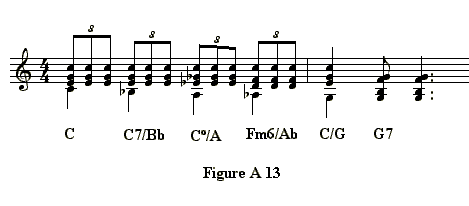
This occurs in different variations, sometimes with fewer notes and with different rhythms. It is common in introductions and turnarounds.
The chord descriptions shown in the figure are typical of what is shown on sheet music. These are complex and can be translated as follows:
| C7/Bb | C7 over a B flat bass |
| C°/A | C diminished 7th over an A bass |
| Fm6/Ab | F minor 6 over an A flat bass |
To understand what is going on here it is necessary to think of this NOT as a chord progression (or at least not as a ROOT progression) but as a linear progression.
What is happening here is that the C chord is not being superseded by new structural chords but rather is being prolonged by three descending step-by-step chromatic lines that create a series of passing chords.
In the lowest notes (effectively the bass part) the line goes: C - Bb - A - AB - G and there are parallel lines going: G - Gb - F - E and E - Eb - D - C. This can be shown in harmonic outline as follows:
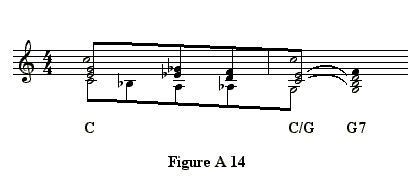
The white notes represents notes of structural chords and the black notes
are the passing notes that make up the linear progressions. The beams
show the connections between the notes involved in each linear progression.
Some linear progressions have just one moving line, some have two in parallel and some have only one line. This one has three. Some even have lines moving in different directions!
This example has all the characteristics of a classic linear progression, as follows:
- The linear progressions connects two structural chords (both chord
I, but in different inversions, in this example)
- Each line of the progression starts and ends on notes of structural
chords. Here, lines all start and end on C, E and G from the C major
chords.
- The moving lines of the linear progressions are accompanied by nonmoving notes which are retained from the notes of the starting chord. In this example a repeated C note.
(Students of counterpoint may recognise this as arising out of the rules of 3rd species counterpoint.)
At the end of this linear progression, the Chord I, in second inversion (C over a G bass), resolves onto a G 7 chord. This type of second inversion tonic chord is referred to as the 'cadential 6 4 chord' as it normally occurs at cadences and serves to decorate the final chord V. The second inversion is made up of notes a 6th and a 4th above the bass (C and E above G, in this example) which 'resolve' downward to form the 5th and 3rd of the dominant chord.
Although a simple example, this is a good introduction to the subject of linear progressions and highlights how we need to take account of both root progressions and linear progressions in order to understood how chord progressions work.
Other variations of the 12 bar blues pattern can be explained by the addition of passing chords and linear progressions.
For more on passing chords please refer to Chapter 3 and for linear progressions see Chapter 4.
Linear Progressions sometimes connect different structural chords together. In the Led Zeppelin song, Custard Pie a linear progression is made up of chromatic power chords which connect chord IV to the chord I7 of the standard 12 bar blues. The progression is:
D - C#5 - C5 - B5 - Bb5 - A7
D is chord IV (no 7th added) and A7 is chord I 7. This occurs in bar 6 of the standard 12 bar blues pattern.
The (12 bar) blues progression is a good example of the basic tonal phrase structure in its 'static harmony only' form. This blues structure has evolved into a variety of structures but the most important development of the 12 bar blues pattern is what happens when the blues is combined with modal harmony. And that is the subject of the next section.
Next Section - Modal and 'Blues-Modal' Harmony

